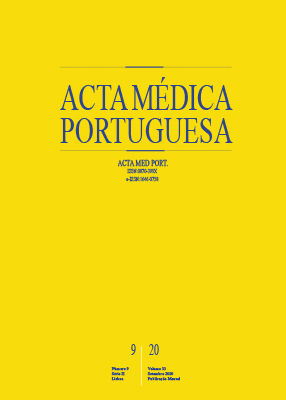Cytomegalovirus Reactivation in Patients with Sepsis in an Intensive Care Unit in Portugal
DOI:
https://doi.org/10.20344/amp.12993Keywords:
Critical Care, Cytomegalovirus, Portugal, Sepsis, Virus ActivationAbstract
Introduction: In the last few years, cytomegalovirus reactivation has been considered an aggravating factor for septic patients in Intensive Care units. The main objectives of this study were to determine cytomegalovirus reactivation in patients with a diagnosis of sepsis admitted to an intensive care unit, and whether this reactivation was related to the evolution of the patient’s clinical condition.
Material and Methods: The detection of cytomegalovirus DNA was performed by real-time polymerase chain reaction and the concentration of nine cytokines (IL-1α, IL-1β, IL-2, IL-4, IL-6, IL-8, IL- TNF-α, and INFγ) were determined by a Multiplex ELISA technique.
Results: Eight of 22 septic patients (36.3%) from the Intensive Care Unit of the Hospital da Luz had cytomegalovirus reactivation. No association was found between cytomegalovirus reactivation and gender, age, length of Intensive Care unit stay, duration of mechanical ventilation, and patient death. No significant differences were found in cytokine concentrations in patients with and without reactivation. However, patients with cytomegalovirus reactivation had a longer hospital stay from Intensive Care unit entry to hospital discharge or patient death (p = 0.025).
Discussion: Despite the low sampling rate, the present study suggests that reactivation is a frequent event in patients diagnosed with sepsis and may be related to prolonged hospital stay in these patients.
Conclusion: The overall analysis of the results obtained and the literature review do not support the concept that cytomegalovirus monitoring should be implemented in routine practice, but it seems prudent to wait for further randomized trials using antiviral prophylaxis, before assuming a definitive attitude towards the role of cytomegalovirus in sepsis.
Downloads
Downloads
Published
How to Cite
Issue
Section
License
All the articles published in the AMP are open access and comply with the requirements of funding agencies or academic institutions. The AMP is governed by the terms of the Creative Commons ‘Attribution – Non-Commercial Use - (CC-BY-NC)’ license, regarding the use by third parties.
It is the author’s responsibility to obtain approval for the reproduction of figures, tables, etc. from other publications.
Upon acceptance of an article for publication, the authors will be asked to complete the ICMJE “Copyright Liability and Copyright Sharing Statement “(http://www.actamedicaportuguesa.com/info/AMP-NormasPublicacao.pdf) and the “Declaration of Potential Conflicts of Interest” (http:// www.icmje.org/conflicts-of-interest). An e-mail will be sent to the corresponding author to acknowledge receipt of the manuscript.
After publication, the authors are authorised to make their articles available in repositories of their institutions of origin, as long as they always mention where they were published and according to the Creative Commons license.









